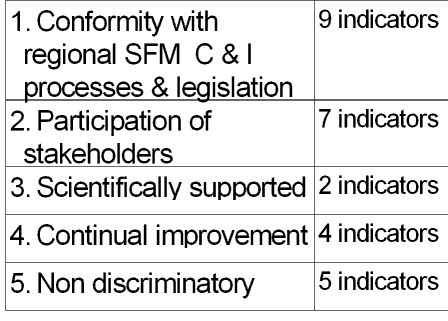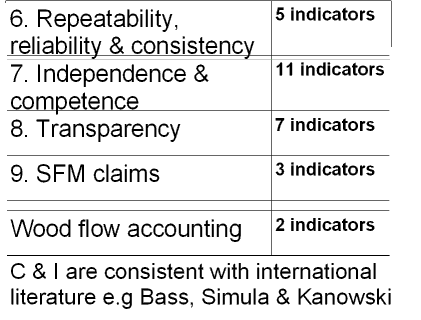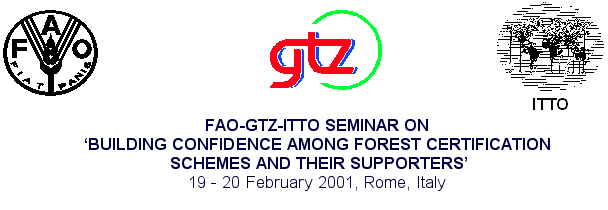 FAO-GTZ-ITTO FAO-GTZ-ITTO
Seminar on Building Confidence among Forest Certification
Schemes and their supporters
19th and 20th February, Rome
Creating an International Mutual Recognition
Framework
International
Forest Industry Roundtable
Working Group on Mutual Recognition
|
Certification & International Mutual
Recognition
James Griffiths:
Chief Executive, New Zealand Forest Industries Council
Chair -
International Forest Industry Roundtable Working Group on Mutual
Recognition
Presentation objectives:
1. WHAT is Mutual Recognition?
2. WHY is Mutual Recognition
important?
3. HOW is Mutual Recognition possible? |
International Forest Industry Roundtable
· IFIR = network of industry associations:
- US, Canada, Mexico, Brazil, Chile, Sweden, Finland, Norway,France,
UK, South Africa, Australia, NZ and CEPI
- natural and plantation
systems
- developed & developing nations (expanding
participation)
- existing & emerging forestry nations
- 56 %
industrial wood production
· Annual meetings since 1994
· Focus on Sustainable Forest Management issues:
- 1996 SFM Vision, Elements & Principles
- 1999/2000 Working
Group on Mutual Recognition
· multi-disciplinary team, extensive standard setting & "mutual
recognition" experiences e.g. Sweden FSC, SFI, FFCA, CSA, UKWAS, PEFC
|
Roundtable Working Group - Timeline
- Mutual Recognition concept
· promoted at World Bank/WWF Alliance Workshop on
Verification/Certification, Washington, DC, Nov 1999
- Mutual Recognition Framework Proposal presented:
· International Forum Forest & Paper Associations & FAO
Advisory Committee Paper & Wood Products, May 2000, Rotorua, New
Zealand
· FAO Asia Pacific Forestry Commission, June 2000, Noosa,
Australia
· PEFCC/EC Seminar on Mutual Recognition, June 2000,
Brussels, Belgium
· International Certification Conference, October,
2000, Hobart, Australia
· 7th International FI Roundtable, October
2000, Marysville, Australia
· SILVOTECNA XV, November 2000,
Concepcion, Chile
· CEPI 2nd International MR Seminar, November 2000,
Brussels, Belgium
· PaperWeek International Open Forum, Jan 2001,
Montreal, Canada
- Framework report - a "work in progress"
· discussed and evaluated by some key stakeholders
· reviewed by
independent consultants
· referenced and reviewed in academic
literature |
What is Mutual Recognition?
Reciprocal and non-discriminatory
arrangements under which one certification system owner recognises
and accepts other certification systems as being
substantively equivalent in intent, outcomes and process in
identified critical elements. |
What are the Roundtable's Mutual Recognition objectives?
1.Enable mutual recognition arrangements between credible
certification systems
2.Provide assurance to customers that participating systems
produce substantially equivalent outcomes
3.Significantly expand availability of certified products to
meet market demand
4.Enable customers to adopt inclusive purchasing policies
recognising regional differences
5.Prevent discrimination by providing an open market for
products from sustainably managed forests |
Why is Mutual Recognition
important?
Without a solution:
· Confusion in the market
·
Decline in perceptions
· Compliance cost
· Further trade
barriers
· Government regulation |
How can Mutual Recognition work?
· Involves proof of substantive equivalence
· Based on core processes and elements that constitute a
credible system
· Reciprocal exchange of belief between
stakeholders |
International Framework Components
1. Representative management structure
2. Independent quality assurance group
3. Analytical tools to assess substantive equivalence
· Criteria & Indicators for credible standards &
systems
· Questionnaire to measure "conformance" against C &
I
· Glossary |
Management structures
· Board representing all participating stakeholders
· Secretariat with technical competence
· Independent quality assurance group to assure
credibility of participating systems |
Analytical tools - Criteria &
Indicators
· Agreed "core" processes and elements which in combination constitute
a credible system i.e. deserving of trust and belief
· C & I covering:
· Measuring stick or template for "credibility" |
Analytical tools cont..
Nine Criteria & fifty three Indicators
defining credibility

|
Criteria & Indicators cont..

|
Criteria & Indicators cont...Illustration theme # 9 - SFM Claims
|
| Criteria |
Indicators |
| Certification procedures shall include guidelines that ensure all SFM claims are clear, unambiguous, substantiated, and consistent with relevant national and international laws, standards and guidelines |
1) A clear set of guidelines governing SFM claims has been agreed and is readily available
2) The guidelines accord with relevant national and international laws, standards and guidelines regarding claims and labels
3) Procedures have been developed to monitor and handle complaints concerning SFM claims
|
|
Analytical tools cont..
Comparative Methodology
- Questionnaire to help determine conformance to Criteria
& Indicators
- Results provide platform for mutual recognition
- Site visits (to build confidence)
- note: questionnaire yet to be adapted
|
Analytical tools cont..
SFM glossary & terminology
- ISO 14050 glossary
- ISO Technical Report 14061
|
International Mutual Recognition Framework - Summary: What & Why?
1. Customers and consumers want to give preference
2. Independent certification can provide assurance
3. No single system can establish a monopoly but in
combination expanding demand might be met (via an International
Framework)
4. Provide critical mass of product from different standards
& systems that are substantially equivalent
5. "Threshold" differentiates credible from
non-credible approaches (i.e. conformance against C & I of
credibility) |
International Mutual Recognition Framework - Summary: Benefits
1. Assurance to customers
2. Critical mass of credible certified product
3. Improves flexibility to purchase products that contributes
to SFM
4. Creates an open market for wood products from any region
providing from sustainable managed sources |
International Mutual Recognition Framework
Roundtable Action plan - establish the Framework to enable mutual
recognition arrangements between credible systems during 2001:
- Phase one - Build "critical mass"
· Roundtable facilitation role
· Stakeholder
discussion, review & refinement
· Cooperation other mutual recognition processes
- Phase two - Implementation
|
International Mutual Recognition Framework
COMMENTS
DISCUSSION
PARTICIPATION |



